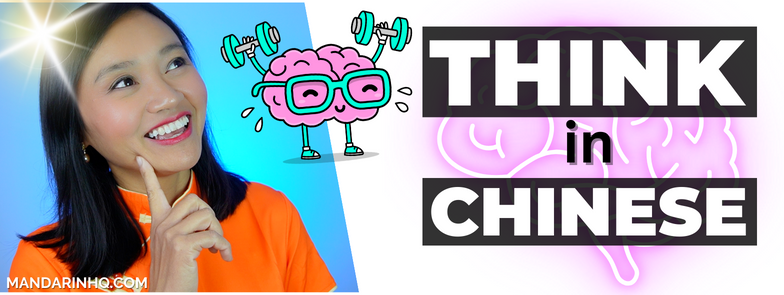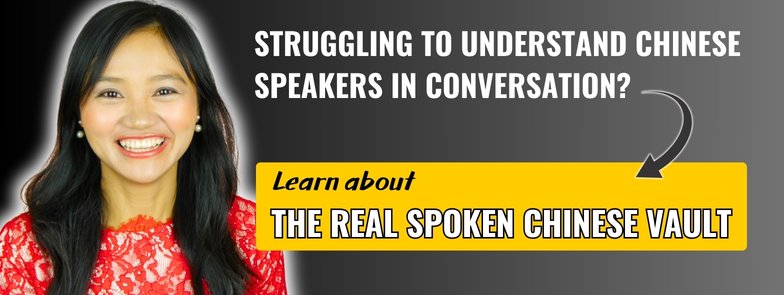If you're able to think in Chinese and stop translating words in your head, you can answer questions faster and converse more fluently!
Fortunately, thinking in Chinese is a skill that you can develop.
And it doesn't matter what your current Mandarin level is...
The techniques I'm about to guide you through can be used anywhere by anyone!
How to THINK in Mandarin Chinese
Today, we're gonna train your brain to THINK in Chinese .
So if you want to stop translating in your head… and start speaking Mandarin more fluently. Then watch this video till the end!
Technique 1: Narrating
A great way to start thinking in Chinese, is to narrate your daily activities in your head. When you wake up in the morning, think '我起床了wǒ qǐchuáng le' (I got up).
When you're eating breakfast, think '我在吃早餐wǒ zài chī zǎocān' (I'm eating breakfast).
You can practice narrating what you do or see anywhere.
So what are YOU doing right now?
Answer (in the video): "我在…wǒ zài…"
Answer (in the video): "我在看视频。wǒ zài kàn shìpín. "(I'm watching a video.)
Narrating helps reinforce words and sentence patterns you already know. It also makes you aware of what you don’t know, so you can learn what you need.
Technique 2: Naming
A simple version of narrating is to just name what you see (or hear, smell, taste, feel…) with single words.
This could be nouns (things), adjectives (words that describe nouns) or verbs (actions).
So let’s practice together:
Try to think of the name of the things in Chinese this picture.
Let’s check the answers (numbers correspond to highlighted items in the video):
1) qián (钱) - Money
2) qiánbāo (钱包) - Wallet
3) xìnyòngkǎ (信用卡) - Credit card
4) bǐjìběn (笔记本) - Notebook
5) zhào xiàng jī (照相机) - Camera
6) màozi (帽子) - Hat
7) shǒujī (手机) - Cellphone
8) jīpiào (机票) - Air ticket
9) yǎnjìng (眼镜) - Glasses
10) shǒubiǎo (手表) - Watch
11) iPad
Now you will have ten seconds to look at the picture and think of some ADJECTIVES that describe these things.
Maybe you thought of:
1) hēi (黑) - Black
2) lán (蓝) - Blue
3) guìzhòng (贵重) - Valuable
4) zhòngyào (重要) - Important
5) qīng (轻) - Light
6) or fāngbiàn (方便) - Convenient
Now, let’s try the same thing with VERBS (So, what can you DO with these things)
Did you think of :
1) chuān (穿) - Wear
2) fēi (飞) - Fly
3) pāi zhàopiàn (拍照片) - Take pictures
4) mǎi dōngxi (买东西) - Buy things
5) wán yóuxì (玩游戏) - Play games
6) gàozhī shíjiān (告知时间) - Maybe tell the time
Now if you find yourself thinking in your own native language first, don’t worry.
Just try your best to think in Chinese!
So let’s repeat the exercise with a different picture.
First, name the things in this picture.
Let’s check the answers (numbers correspond to highlighted items in the video):
1) píngguǒ (苹果) - Apple
2) lánméi (蓝莓) - Blueberries
3) sānwényú (三文鱼) - Salmon
4) xīlánhuā (西兰花) - Broccoli
5) qiézi (茄子) - Eggplant
6) niúyóuguǒ (牛油果) - Avocado
7) mógu (蘑菇) - Mushroom
8) jiānguǒ (坚果) - Nuts
9) làjiāo (辣椒) - Chili
10) qīngdòu (青豆) - Green bean
Now, look at the picture and think of ADJECTIVES.
Maybe you thought of:
1) lǜsè (绿色) - Green
2) hóngsè (红色) - Red
3) jiànkāng (健康) - Healthy
4) tián (甜) - Sweet
5) xiǎo (小) - Small
6) or hǎochī (好吃) - Tasty
Now what VERBS do you think of?
Did you think of:
1) chī (吃) - Eat
2) xǐ (洗) - Wash
3) xiāo (削) - Peel
4) zhǔ (煮) - Cook
5) shāokāi (烧开) - Boil
6) or maybe zhá (炸) - Fry
We’re going to use one more picture:
If you’re a beginner, you can think of single words.
And if you're a bit more advanced, think of phrases or sentences.
You have 15 seconds, starting now!
Some of the things I thought of were:
1) fěn sè de màozi (粉色的帽子) - Pink hat
2) huáng sè de yǎnjìng (黄色的眼镜) - Yellow sunglasses.
3) tā yǒu cháng tóufa. (她有长头发。) - She's got long hair .
4) tā zài xiào. (他在笑。) - He's laughing.
5) tāmen dōu gāoxìng. (他们都高兴。) - They're all happy.
Now, for the final challenge. You’re going to look around you and describe what you see. It can be single words or longer phrases.
You have 15 seconds, starting now!
How did it go?
The more often you do this type of practice, the easier it gets!
And when you notice that there’s an important word you don’t know, that’s a great opportunity to look it up and learn it!
FINAL TIPS
Before we wrap up the lesson I want to give you 3 simple tips to help you stop translating in your head.
Tip #1:
When you learn a new word or phrase, don't just memorize the translation. Instead, associate it with an image, or a situation. For example, when you learn the word "猫 māo" (cat), don't think of the English word "cat". Instead, picture a cat in your mind.
Tip #2:
The second tip is to immerse yourself in the language.
Listen to Chinese music, watch Chinese TV shows, read Chinese books
The more you expose yourself to the language, the more natural it will feel.
Tip #3 :
Finally, the more you use Chinese, the easier it will be to think in Chinese. So, start speaking as much as you can, even if it's just to yourself.
And that's it for today! If you want to improve your ability to think in Chinese quickly, practice naming and narrating a few minutes every day.
谢谢 Xièxiè. See you in the next lesson!
You might also find these posts interesting:





